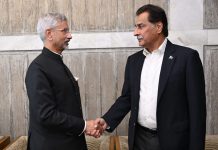Izmi Herlani
In recent weeks, the Indo-Pakistani relationship has once again been thrust into the spotlight following the Pahalgam attack, which many analysts and observers have labeled a false flag operation. This incident appears to follow a troubling pattern, reminiscent of previous strategies employed to malign Pakistan. Not only does this current situation highlight the delicate geopolitical environment of South Asia, but it also raises important questions about the motives behind such orchestrations.
The strategic objectives of the Pahalgam attack seem multifaceted, but a primary aim appears to be upholding the declining popularity of the current BJP government in India. With mounting pressure from various segments of the Indian society regarding economic issues and handling of internal disputes, the BJP could be seeking to re-establish a narrative through an external enemy. By invoking nationalist sentiments, the fascist government aims rally support and deflect attention from domestic turmoil.
Another important context for this standoff is the international scrutiny faced by India concerning Human Rights violations in Indian Illegally Occupied Jammu and Kashmir (IIOJK). The ongoing plight of the Kashmiri people has drawn international condemnation and the Pahalgam incident serves as a distraction from these human rights issues. By alleging Pakistan’s involvement in such attacks, India aims to divert global attention and regain the upper hand in the court of public opinion.
Moreover, the purported objectives of this irrational plot could also include seeking leverage from the Trump administration regarding trade tariffs and create economic pressure on Pakistan. The geopolitical dynamics have shifted significantly in recent years, and any incident that portrays Pakistan negatively could be used to enhance India’s negotiating position with respect to U.S. policy initiatives. India’s historical efforts to paint itself as a victim in the regional geopolitical arena allow it to seek favorable outcomes in trade discussions while simultaneously strangling Pakistan economically by stopping the flow of rivers.
At this juncture, it is imperative to recognize the role of the Pakistan Armed Forces, specifically the Pakistan Air Force (PAF), which has a longstanding history of defending the motherland. The brave Shaheens of the PAF have demonstrated unwavering commitment, pledging to protect Pakistan at all costs. The spirit of dedication among the armed forces runs deep, and the rich legacy of sacrifice and valor continues to inspire future generations. PAF’s operational readiness has been the hallmark of the force which was exhibited in 1965 & 1971 wars and once again came to the fore in February 2019, when India launched a unilateral irrational aggressive military campaign across the LoC. Responding to this unprovoked aggression, PAF displayed remarkable professionalism and heroism, executing precise strikes, downing IAF fighter jets and effectively safeguarding national sovereignty. The outcome of this confrontation demonstrated PAF’s capability to respond strongly to acts of aggression, a message that resonates with its adversaries even today.
In light of the current standoff, PAF remains prepared and vigilant, equipped with advanced training and operational strategies. The commitment to excellence, combined with the brave resolve of the personnel, ensures that if war is imposed on Pakistan, Pakistan Air Force will once again rise to the occasion, defending the homeland with extreme prowess. Further evidence of the PAF’s strong position lies in its recent military acquisitions and indigenization efforts. Under the current leadership, there has been a significant push towards modernizing the Air Force, with notable advancements reflected in cutting-edge technologies and indigenized production capabilities. Projects such as the JF-17 Thunder program, the leaps in space, cyber, artificial intelligence and unmanned aerial systems domains have significantly enhanced Pakistan’s air defence capabilities, putting the PAF steps ahead of its adversary in terms of operational effectiveness. The PAF’s narrative is not one of mere preparedness; it is backed by tangible accomplishments that affirm its superior capability and capacity. There is a collective resolve among military leaders and personnel that any foolish act of aggression will be met with full force. The message is clear: not only can Pakistan defend itself, but it also has the ability to counteract any threats that may threaten its sovereignty.
The standoff between India and Pakistan, exacerbated by the Pahalgam attack, underscores a complex web of strategic objectives and historical context. While India may attempt to leverage this incident for political gains, the international community must remain vigilant and discerning about the implications of such actions, especially regarding human rights concerns in the region. Pakistan Armed Force stands resolute, armed with a legacy of patriotism and unparalleled professionalism, ready to defend the nation against any aggression. It is imperative that Pakistan continues to strengthen its defence capabilities while also advocating for peace and stability in South Asia. The sacrifices of our brave Shaheens have paved the way for a robust defence posture that will ensure Pakistan remains secure in the face of adversity.

















